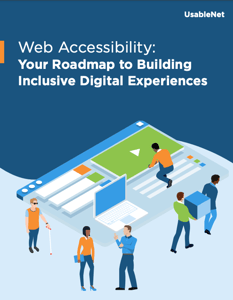Digital accessibility, even in 2021, is often treated by many brands as an afterthought. Yet, your digital accessibility initiative should be more than meeting legal requirements or a few technical steps to toss over to their site design and UX team. Digital accessibility including web accessibility and mobile accessibility should be integral to your organization.
There are five pillars that reflect the importance of why digital accessibility should be so central to your brand. We'll call these pillars the 5 R's.
Keep reading to discover each R and how it relates to the importance of digital accessibility for your brand. Editor's Note: This post summarizes key content from our Global Accessibility Awareness Webinar co-hosted by TTC Global.
The 5 R’s
There are 5 core reasons (or the 5 R’s) why digital accessibility should be part of your brand’s DNA. Let’s look at each.
1. Reputation
Failing to have a fully accessible digital presence can negatively impact your presence right away. One out of three people either has a disability themselves or knows someone with a disability. These people will be quick to lose respect for brands who aren’t prioritizing equal access to all users in a way that prevents themselves or someone they care about from access.
Sheri Byrne Haber, Founder of the VMWare accessibility program spoke from her own experience about the impression a brand makes when its website is not accessible in a video created for 2021 Global Accessibility Awareness Day. Watch the video in full and hear from more accessibility industry experts here.
"When you don't make your websites accessible you're telling me that you're not interested in my business and that you don't care about my daughter. And I'll go to a competitor who does care and I'll make sure all of my friends and colleagues know that. Maybe I'll complain to you as a business. Maybe I won't, but in the end you will have lost the customer, forever."
The reality is that most users with disabilities won't let you know that they can't access your website or app, only a small percentage of people with disabilities take legal action. Yet, there may be many people who will take their business elsewhere and speak about their negative experiences.
2. Recruitment
How do people apply to work with your business, either as a vendor, contractor, or employee?
In most cases, job applications are all online now. And if you want to attract the absolute best talent, you need to open up your applicants to the full candidate pool.
It’s important to cast a wide net, and that means having accessible platforms that allow users with disabilities to apply for roles that suit their skills.
3. Retention
Employee retention rates can directly impact a business’s financial and cultural success. The last thing that you want to happen is to lose a long-term employee who becomes disabled as they age, or to rule out great candidates because your internal interface isn’t fully accessible.
The digital systems we ask our employees to use daily must be created with accessibility in mind.
This can be an ongoing process. Our Head of Sales and Marketing, Chris Werely explains how UsableNet has worked on our own internal systems to be accessible. We also push our vendors to deliver accessible systems. Watch this video in full and hear from other UsableNet team members about digital accessibility here.
"What we're doing as a company is looking at everything and how we make it easier,
more accessible, and more usable for everybody. We're a 20-year-old company. So we've
gone back to make sure everything is usable and as accessible as possible. We've updated our CRM, our proposal generation processes to make them better. We've gotten really positive feedback from everybody on that."
4. Risk Mitigation
The last thing most brands would want is to find themselves on the defense side of an ADA lawsuit. It’s expensive, it’s time-consuming, and you could be stuck paying legal fees and settlements just to have to make the changes anyway.
Following the WCAG 2.1 on mobile and desktop can help you avoid ADA lawsuits in the United States.
5. Rights
People with disabilities have legally sanctioned rights to fair access and accommodation to organizations. They have the right to an education, employment, and family life, and they have rights as a consumer.
Since everything is accessed online today, especially following the COVID-19 pandemic, those rights are important.
What’s Good for One is Good for Many
When you’re considering why digital accessibility is so important to your brand, keep in mind that the British motto of “What’s good for one is good for many” holds true here, too.
Closed captions are a good example. They were designed for people who were deaf or hard of hearing, but they’re now available to all users on most television and video streaming platforms.
People who are not deaf or hard of hearing also regularly use closed captions for a large number of reasons. It was necessary for one niche group of users, but it was positive for a large number of users overall.
The ability to enlarge text on a screen is another great example. This was created for users who were low-sight, but a large number of people take advantage of this feature who don’t have any sight limitations.
Why a Digital Accessibility Partnership Can Be Key
As you’re weaving digital accessibility into your brand’s core, the reality is that this is hard work upfront and that there’s a lot to learn.
Having a professional partner with in-depth knowledge of digital accessibility can be a huge asset. Need help changing your brand’s digital accessibility journey? UsableNet can help. See our services or contact us for a customized consultation.
Not ready to speak with an expert quite yet? Discover more about what your digital accessibility journey might entail by reading our new guide for digital accessibility for 2021, "Web Accessibility: Your Roadmap to Building Inclusive Digital Experiences.








